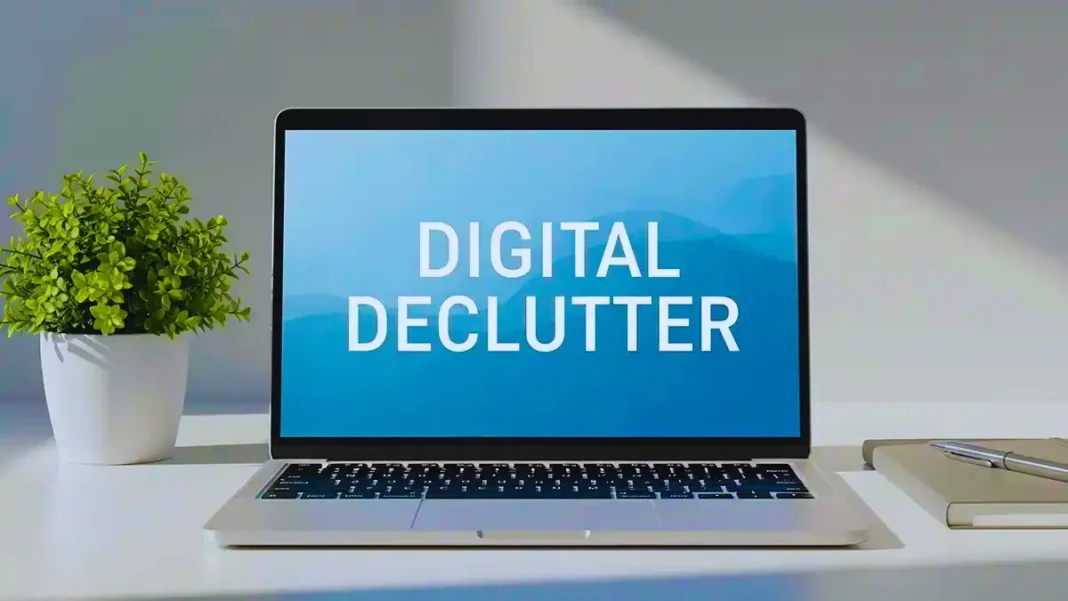In our hyper-connected world, the constant influx of notifications, overflowing inboxes and endless digital files can feel overwhelmingly chaotic. But what if there was a way to reclaim your digital peace, boost your productivity and reduce the silent stress of digital overload? In this article, you will embark on a journey into digital declutter.
Uncovering why it’s essential for modern well-being, explore practical strategies for taming your digital chaos across devices, learn effective digital detox tips and ultimately discover how to embrace a more streamlined and intentional online existence.
The Growing Need for Digital Declutter
Our lives are increasingly intertwined with digital devices, from smartphones and laptops to smart home gadgets. While these tools offer unparalleled convenience, they also generate an immense amount of data and distractions, leading to what many call “digital clutter.” This constant accumulation impacts our mental clarity and productivity.
The Silent Burden of Digital Clutter
Just as physical clutter can create a sense of overwhelm in our homes, digital clutter has a similar, often unacknowledged, effect on our minds.
An overflowing email inbox, a desktop swamped with unorganized files, or a phone laden with unused apps can lead to increased stress, anxiety and a diminished sense of control.
This digital chaos can drain mental energy, making it harder to focus on important tasks and leading to feelings of being constantly behind. Recognizing this silent burden is the first crucial step towards effective digital declutter.
Benefits Beyond Organization: Focus and Well-being
The advantages of a thorough digital declutter extend far beyond mere organization. By systematically removing unnecessary digital distractions, you can significantly enhance your attention span and improve your ability to concentrate on high-value activities.
Fewer notifications mean fewer interruptions, allowing for deeper work and more mindful engagement with your digital tools.
Psychologically, achieving a clean digital space can lead to a profound sense of accomplishment, reduce mental fatigue and foster a greater sense of calm and control over your technological life, contributing to overall well-being.
Core Principles of Digital Declutter
At the heart of successful digital declutter lies the philosophy of digital minimalism. This approach isn’t about shunning technology entirely but rather about using it intentionally, ensuring that every digital tool and interaction serves a meaningful purpose in your life. It encourages thoughtful engagement rather than passive consumption.
Intentionality Over Default Settings
Digital minimalism emphasizes intentionality. Instead of passively accepting every default setting, notification, or social media feed, you actively choose which digital tools to use, how to use them and when.
This involves critically evaluating the value each app or platform brings to your life and consciously opting out of those that drain your time or attention without offering substantial benefit.
It’s about building a digital life around your values, rather than letting technology dictate your habits. This proactive approach is key to long-term digital well-being.
Less is More: Curating Your Digital Environment
The “less is more” mantra is central to digital minimalism. This means a ruthless culling of unnecessary apps, files, subscriptions and digital accounts. The goal is to curate a streamlined digital environment where every item serves a specific purpose, contributing positively to your goals or well-being.
By reducing cognitive load and visual noise, you create a more efficient and peaceful digital space. This approach helps prevent future clutter accumulation, making maintenance simpler and fostering a sense of clarity.
Practical Steps for a Comprehensive Digital Declutter
Embarking on a comprehensive digital declutter involves tackling various aspects of your digital life, from your devices to your online presence. Breaking down the process into manageable steps makes it less daunting and more achievable, allowing you to systematically clear out the digital noise.
Taming Your Inbox: Email Management Strategies
An overflowing email inbox is a major source of digital stress for many. Effective email management begins with unsubscribing from newsletters and promotional emails you no longer read.
Implement the “four D’s” method: Delete (unnecessary), Do (immediate actions), Defer (for later) and Delegate (to others). Utilize folders, labels and filters to automatically sort incoming mail, keeping your primary inbox clean.
Schedule specific times to check emails rather than being constantly tethered to it, transforming your inbox from a source of anxiety into an organized communication hub.
Organizing Your Files and Photos: Device Cleanup
Your computer and phone are often repositories of countless unorganized files and duplicate photos. Start by creating a consistent, hierarchical folder structure for your documents, using clear naming conventions.
For photos, delete duplicates and blurry shots, then organize the rest by date or event into albums. Consider cloud storage solutions like Google Photos or iCloud for backup and easy access, while removing old, unnecessary files from your device’s local storage.
Regularly clear your desktop and downloads folder, treating them as temporary holding areas rather than permanent storage.
Reclaiming Your Phone: App and Notification Audit
Your smartphone is a powerful tool but often a major source of distraction. Perform a thorough app audit: delete any apps you haven’t used in the past month.
Group remaining apps into intuitive folders. Crucially, manage your notifications. Turn off all non-essential alerts, leaving only critical ones.
This drastically reduces interruptions and prevents apps from constantly vying for your attention. Consider grayscale mode or digital detox tips like setting app time limits to reduce screen addiction and foster more intentional phone usage.
Beyond the Initial Clean-Up: Sustaining Digital Health
A single digital declutter is a great start, but maintaining a healthy digital environment requires ongoing effort and the development of new habits. This commitment to continuous organization ensures long-term peace of mind and sustained productivity in your digital life.
Creating Digital Boundaries and Habits
Sustaining your digital health means establishing clear boundaries. Set “tech-free zones” in your home, such as the bedroom or dining table, where devices are prohibited. Implement “digital quiet hours” before bed or during family time.
Develop habits like a weekly “digital reset” where you quickly clean up files, clear downloads and manage your inbox.
These routines help prevent clutter from accumulating again and reinforce your commitment to a more balanced digital lifestyle, making it a continuous process rather than a one-off event.
Practicing Regular Digital Detoxes
Even with a well-organized digital space, periodic digital detox tips are vital. A digital detox involves intentionally disconnecting from screens and online platforms for a set period – whether it’s a few hours, a full day, or even a weekend.
Use this time to engage in offline activities: read a book, spend time outdoors, pursue a hobby, or connect with loved ones face-to-face.
These breaks allow your mind to reset, reduce screen fatigue and remind you of the rich experiences available beyond the digital realm, reinforcing the benefits of your initial digital declutter.
Embracing Digital Well-being for a Better Life
Ultimately, digital declutter isn’t just about tidiness; it’s about optimizing your digital life to support your overall well-being. It empowers you to be in control of your technology, rather than letting your technology control you, leading to a more fulfilling existence.
Enhancing Mental Clarity and Focus
A decluttered digital environment directly contributes to enhanced mental clarity. When you’re not constantly bombarded by notifications or distracted by unorganized files, your brain has more capacity to focus on meaningful tasks.
This improved focus translates to higher productivity, better decision-making and a reduced sense of cognitive overload. By minimizing digital noise, you create a mental space conducive to deep work and creative thinking, allowing you to engage more fully with the world around you and within you, making it a cornerstone of modern self-care.
Improving Productivity and Time Management
A systematic digital declutter streamlines your digital workflows, leading to significant improvements in productivity and time management. When files are easy to find, emails are organized and distractions are minimized, you spend less time searching and more time doing.
This efficiency frees up valuable time for other pursuits, whether it’s personal development, leisure, or spending time with loved ones.
By optimizing your digital tools, you gain greater control over your schedule and can allocate your time more effectively towards your goals, both professional and personal.
The Long-Term Impact on Quality of Life
The long-term impact of consistently practicing digital declutter is a noticeable improvement in overall quality of life. Reduced stress from digital overload, increased focus on meaningful activities and more time for real-world connections contribute to greater happiness and well-being.
It fosters a more intentional relationship with technology, using it as a tool to enhance life rather than letting it become a source of distraction or anxiety. Embracing this practice means cultivating a healthier, more balanced existence in our increasingly digital world.
Conclusion
Embarking on a journey of digital declutter is more than just organizing files and unsubscribing from emails; it’s a profound step towards reclaiming your mental peace and productivity in an increasingly noisy digital landscape. By embracing principles of digital minimalism, implementing practical cleanup strategies for your devices and online presence and committing to ongoing maintenance and digital detox tips, you can transform your relationship with technology.
The benefits are clear: reduced stress, enhanced focus and more time for what truly matters. Take control of your digital life today and discover the profound freedom and clarity that a decluttered digital world can offer.
Frequently Asked Questions (FAQs)
What does “digital declutter” truly mean?
Digital declutter refers to the process of organizing, streamlining and removing unnecessary digital content (files, apps, emails, social media) from your devices and online presence to improve focus and reduce stress.
How often should you perform a digital declutter?
While a major initial digital declutter is beneficial, aim for smaller, regular maintenance sessions weekly or monthly and a more thorough cleanup quarterly or annually to keep things tidy.
Is digital decluttering the same as “digital detox”?
No, digital declutter focuses on organizing and reducing digital clutter, while a digital detox is a temporary, intentional break from all digital devices and online platforms to reset. They complement each other.
What are the main benefits of a digital declutter?
Key benefits include reduced stress and anxiety, improved focus and productivity, better time management, increased device performance and a greater sense of control over your digital life.
How can you handle old photos and videos during a digital declutter?
For photos and videos, delete duplicates, blurry shots and anything irrelevant. Organize the keepers into clear folders by date or event and back them up using cloud storage or an external hard drive.
Also Read:
Best Business Ideas for Women: 37 Ventures Guide Towards Success for 2025


